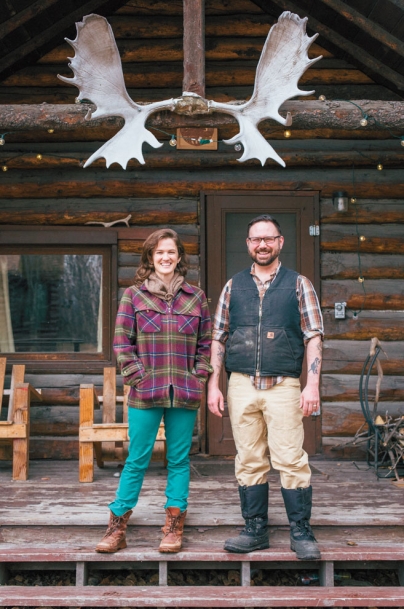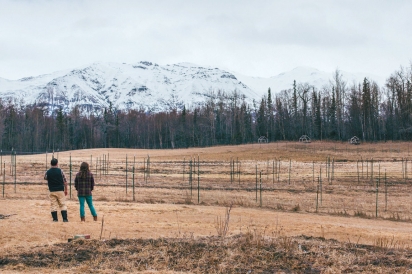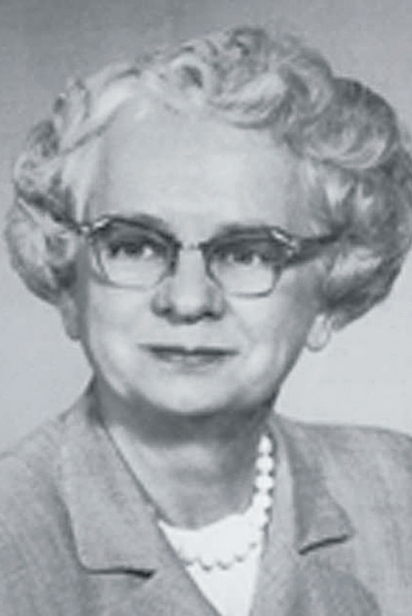Spring Creek Farm
A Labor of Love
Megan Talley and Joshua Faller never dreamt of being farmers. The children of post-Dust Bowl Oklahoma and the defunct dairy towns of rural America, they both grew up witnessing industrial agriculture as a destructive force that held little opportunity for a future. Only later as adults did their paths each turn separately to farming, leading them to meet one another in New York's fertile Hudson Valley. Today, they are the caretakers of Alaska Pacific University’s Spring Creek Farm and leaders of a burgeoning movement for young farmers.
TO THE LAND OF THE MIDNIGHT SUN (AND GIANT CABBAGES)
Spring Creek Farm is a small but vibrant six-acre plot nestled between the majestic Chugach and Talkeetna Mountain ranges in the Matanuska-Susitna Valley. The couple had never stepped foot in Alaska before, but when they heard they got the job at Spring Creek Farm they immediately packed their bags, grabbed their barn cats Whiskey and Dinah, and drove across the country.
In early February 2014, they arrived at the farm in the middle of the night to find a thick layer of ice covering the parking lot. Although they were cold, tired from the long drive, and squinting in the pitch black to find the tiny cabin with moose antlers on the front of it, they knew they were in for an unparalleled adventure. “When we woke up the next morning we saw the mountains surrounding us and thought ‘we’re home’,” recalls Megan.
Over 60 years earlier, Louise Kellogg may have been thinking the exact same thing. In 1948, she took a similar journey north in hope of becoming a farmer. As a single woman, however, she found that no one was willing to sell her land, especially without farming experience. Eventually she bought 240 acres and ten cows from the Loessing family. Over the years she designed and built a barn and cabin and her dairy farm quickly became known for producing some of the best milk in the Valley. As other farms nearby failed or farmers chose to leave Alaska, Louise bought up their land. Beyond her role as a leader in Alaska’s dairy industry, she was also instrumental in shaping the Mat-Su Borough and was later inducted into the Alaska Women’s Hall of Fame.
Upon her death in 2000, Louise gifted her land to Alaska Pacific University under the agreement that the 900 acres of wilderness and farmland be preserved and used for educational purposes in perpetuity. In this spirit, Alaska Pacific University created Spring Creek Farm as a way to honor her legacy and bring outdoor education, sustainable agriculture, and classroom learning together. “Education happens naturally in the field,” says Megan. “That is something that Louise taught us all.”
Today, Louise’s foresight is striking. Spring Creek Farm is located in the heart of the fastest growing region in Alaska. The proximity to development is a constant reminder to Joshua and Megan of how important their jobs are. “Across the country, we are losing farmland every day,” worries Joshua. “In Alaska, farmland being developed means less opportunity for the next generation of farmers.”
Megan emphasizes the role of education and how fortunate they are to be farming in a place with such a rich history. “Now more than ever, there needs to be a place for people to learn how to grow food, to be outdoors, to learn what wild foods look like. We are the caretakers of a space that can do all of that. What a privileged position to be in.”
SHARING A MEAL
I meet with Joshua and Megan at the farm over homemade pizza in what was originally Louise’s house. In between bites, I quickly grow to feel like we are old friends. We go on a walk around the farm and they show me where they got married last summer. “By the pizza oven,” jokes Megan. This will be their third season.
Because of it’s educational mission, the goal of Spring Creek is to demonstrate a multitude of business models, from working with institutions like the university dining hall, to selling at a farmers’ market, to talking to the local food bank. “We have a different approach than most farms because our bottom line is teaching the next generation of farmers about their options.” Their rough estimate is that last year 60% of the harvest was sold as Community Supported Agriculture (CSA) shares, 30% was donated, and 10% supplied to the university dining hall.
“For example, a CSA is a good entry model for farmers,” Joshua says. “It can be complicated, but as a new grower it is spectacular to create that type of relationship with your consumer.”
Joshua and Megan are passionate about farming, but at the end of the day everything they do is grounded in food system education and social justice. They recently founded a project called Alaska Tilth to feed vulnerable and needy families who otherwise would not have access to healthy foods. Through this program people can purchase CSA shares from Spring Creek Farm that are donated, providing fresh produce to local senior centers, women’s shelters and food banks.
Our conversation turns back to childhood dreams, when Megan wanted to be a dancer and Joshua a pirate.
“What does it feel like to call yourself a farmer now?” I ask. Joshua pauses thoughtfully before answering. “It was a return for me in a way, but also completely new,” he says. “It would have been an aberration a decade ago, but now is something I take a lot of pride in.” Megan adds, “In a way we are reclaiming what it means to be a farmer and changing the social stigma around it.”
“Across the country, people are trying to breathe life back into farm communities,” says Joshua. “For me, it’s about ‘how do we build a future?’ It’s both a responsibility and a privilege.”







